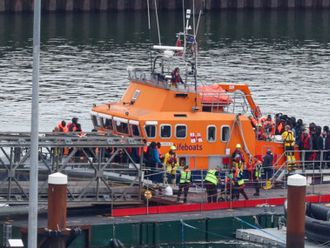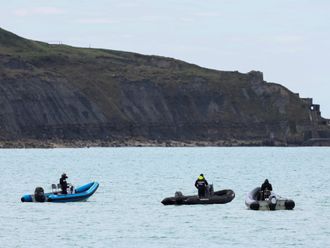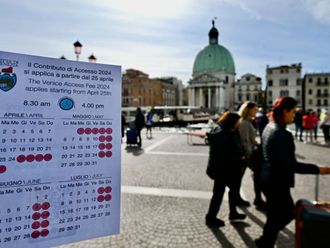DECMN, Czech Republic: Once an ominous harbinger of hard times and even famine due to critically low water levels, a massive “hunger stone” embedded deep in the Elbe River has reappeared in the Czech Republic after Europe’s long, dry summer.
The boulder in the town of Decin, north of the capital, Prague, is roughly the size of a van and bears the foreboding inscription, “If you can see me, then weep”.
Boatman and riverside innkeeper Franz Mayer etched the words in German — “Wenn du mich siehst, dann weine” — during a period of low water in 1904 in the days when the country was part of the Austro-Hungarian Empire.
“Over the centuries, many people earned their living on the Elbe as rafters, and when there wasn’t enough water to float their rafts, they lost their livelihoods,” Vlastimil Pazourek, head of the museum in Decin, told AFP.
“The rafters engraved the dates of those bad years on the soft sandstone boulders typical for this region, hence the name ‘hunger stone’,” Pazourek said.
About 20 such boulders, engraved with markers and dates going back centuries, can still be found on the banks of the Elbe, a major central European waterway running from the Czech Republic through Germany to the North Sea.
Marked “1616”, the hunger stone on the river’s left bank in Decin, which lies 20 kilometres (12 miles) from the German border, bears one of the oldest dates.
Changed river
A lot of water has since flowed under the bridges on the Elbe, which is no longer the same river that Franz Mayer knew when he left his etched lament.
The riverbed has been deepened to ease navigation and its flow has also been altered by nine dams built during the 20th century on the Vltava, its main tributary.
At three metres (10 feet), its average water level in Decin today is about 1.5 metres lower than in 1904, according to Pazourek.
Parts of the hunger stone are usually visible for more than 100 days a year when the water level on the Elbe drops to 160 centimetres, he said.
‘More than historical curiosity’
“The hunger stone is certainly more than just a historical curiosity,” said Jiri Petr, head of dispatching at Povodi Labe, the state-owned company managing river traffic on the Czech stretch of the Elbe.
The water level plunged to just 90cm at the end of August after the long, hot and very dry summer, making large-scale river transport impossible.
Prague experienced its hottest summer since records started in 1775, the weather institute said last week.
“Complications arise when the level of the Elbe in Decin is down to around 250cm, and if it drops below 115cm, river transport is no longer viable,” Petr said.
“A similar situation occurred in 2015 and 2016, but this year, the water level has fallen more rapidly in a way that hasn’t been seen in the last two decades,” he told AFP.
Experts predict ebbing river levels will become the norm in coming years.
“Due to climate change, low river levels will be even more frequent,” the Prague-based Arnika environmental NGO quoted a hydrology specialist in Germany, Tobias Conradt, as saying in a statement.
“What we consider extreme today, will become an everyday reality in the decades to come,” he added.
This year’s drought has affected around 94 per cent of the Czech Republic, causing crop damage estimated at nine to 11 billion koruna (350-427 million euros, $408-500 million), according to the Agrarian Chamber.
Farmers across Europe, including those in usually wetter northern regions like Sweden and the Baltic states, have also suffered from record drought, with many forced to slaughter livestock due to severe shortages of fodder.
Ebbing transport
Up until the 1990s, around five million tonnes of goods were transported on the Elbe each year, but the figure has dramatically fallen to under one million in recent years due to low water.
Controversy surrounds plans to build a new weir on the Elbe in Decin, designed to raise its water level and thus improve navigation.
While it has government support, environmentalists question its viability and fear an irreversible environmental impact.
“Since 2013, transporting goods has been paralysed by low water levels on the Elbe in Germany for up to seven months of the year,” argued Nikol Krejcova, of Arnika.
“Reliable transport on the Elbe up to Hamburg is an unrealistic idea,” he insisted.
If the project goes ahead, the hunger stone will vanish under water, but Decin has no plans to move it to higher ground.
“Certainly not, we won’t lose it. It’ll still be there, just beneath the surface,” said a smiling Pazourek.












